First snowmelt, and a month of dry,
but the rain finally comes,
and everything is flowers, for a time.
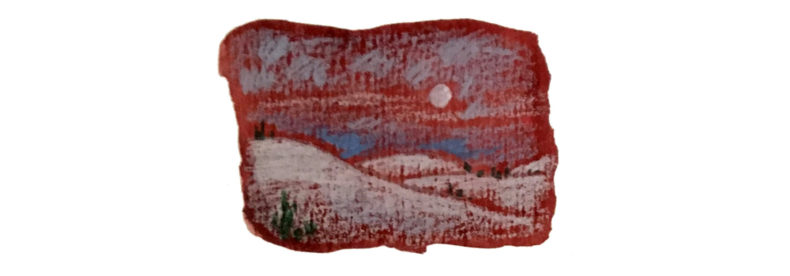
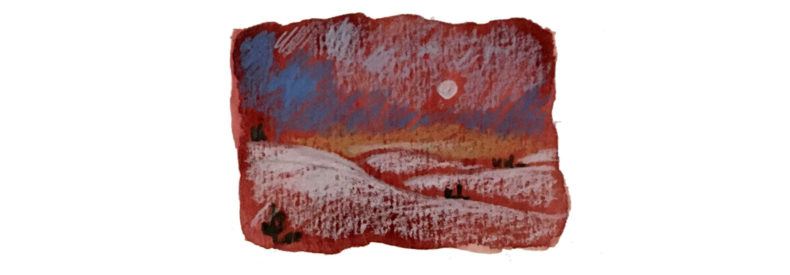
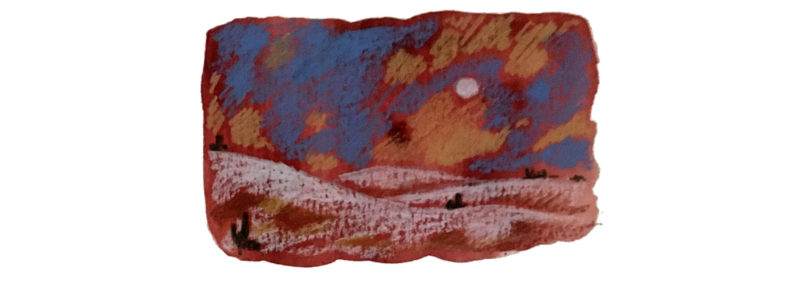
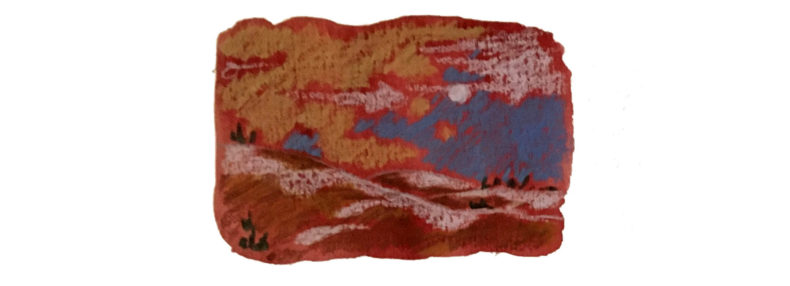
First snowmelt, and a month of dry,
but the rain finally comes,
and everything is flowers, for a time.




I first met Julia Galef while reporting a story about rational thinking for Discover Magazine back in 2014. Galef is co-founder of the Center for Applied Rationality, which she was directing at the time. I attended one of the workshops on rationality that CFAR puts on and was instantly impressed with Galef’s ability to question her own beliefs and identify irrational and unhelpful patterns of thinking. Her ideas have positively shaped my own work habits, and I was thrilled to read her new book, The Scout Mindset: Why Some People See Things Clearly and Others Don’t. The book is a terrific primer on how to think more clearly and with less bias, and if you’re reading this and thinking that you’re not the kind of person who needs such a book, well, that’s a pretty good sign that you are. I spoke with Galef about the book and what it has to offer even the smartest among us.
Christie: Your book is about “The Scout Mindset.” Could you start by explaining a little bit about what this is and how you came to choose this particular metaphor?
Julia: Sure. The Scout Mindset is the book’s title, and it’s also the framing metaphor of the book. Humans are very often, by default, in what I call “soldier mindset,” which is the motivation to defend your pre-existing beliefs or defend the things you want to believe against any evidence that might threaten them. And so you shoot down arguments to the contrary. Scout mindset is an alternative to that. Unlike the soldier, the scout’s role is not to attack or defend. Instead, it’s just to go out and see what’s really out there and try to form as accurate a map as possible of the territory or an issue. A scout mindset is the motivation to try to see things as they are and not as you wish they were. It’s being intellectually honest or objective or just trying to be curious about what’s true.
Christie: I tend to think of this as the idealized version of how the scientific mindset should work, even though, as a science journalist, I’ve often seen that scientists don’t always act that way.
Julia: It does have a lot of overlap with kind of our platonic ideal of what a scientist should be. But I like the scout metaphor, because an accurate map serves such a direct purpose for the scout. You’re trying to form an accurate picture of what’s going on because understanding yourself and other people and how the world works helps you make better decisions. I really wanted to emphasize the practical usefulness of seeing things clearly, and not just the joy of intellectual discovery, even though I love that too.
Christie: One of the main points you make in the book is that everyone falls prey to cognitive biases. We may all aspire to be scouts, but so often the human condition is to fall back on the soldier mindset. You tell a story about this involving a friend of mine, Bethany Brookshire, who’s one of the smartest people I know. How is it that even very sharp people like Bethany can fall into these cognitive traps?
Julia: I love that story, and it made me an instant fan of Bethany. She’s a science journalist, and a few years ago she tweeted something that basically said, I’m a science journalist, and in my email signature, it says I have a Ph.D. This morning when I checked my email I had two emails from scientists who I had contacted requesting an interview. One of the scientists was male and his email to me began, “Dear Ms Brookshire.” The other scientist was female, and her email to me began, “Dear Dr. Brookshire,” and you know, this isn’t a 100 percent correlation, but it’s a definite pattern.
Her tweet really resonated with a lot of people and it kind of went viral, and she got a lot of very validating and supportive comments from other women saying that this really matched their experience too. As the supportive responses came rolling in, Bethany felt a little bit troubled, because she had made this claim about a pattern that exists in the data, but she had made it just kind of off the cuff without actually checking. She had the data sitting in her email, and she kept thinking, “I’m a scientist, shouldn’t I actually check the data?” And so she did.
She went back and collected all of these emails from scientists and she classified them as best she could, and she ran the numbers and discovered that she’d been wrong. There actually wasn’t a strong pattern there, but to the extent that there was, it went in the other direction and wasn’t significant.
The data did not actually support the claim she had made, which does not mean there isn’t gender bias and doesn’t mean that other people’s experience doesn’t show this pattern. It just means that this specific pattern she’d claimed existed in her emails was not actually there. And so she wrote a follow up tweet explaining that she’d run the data and it turns out she was wrong. She apologized and published her data. I was just so impressed with her, and I was gratified that her responses to the follow up tweet were actually quite positive. People really applauded her for her intellectual honesty.
Christie: It’s easy to feel mortified about being wrong, but you talk about how sometimes recognizing and acknowledging that you’re wrong can be very useful.
Julia: Right. Another thing I really liked is that Bethany did this post mortem to ask, why did I get this wrong? And she said, well, one reason is that I was probably influenced by recency bias. These most recent emails showed an example of this phenomenon, and so I over-anchored on that. I thought that that’s such a good thing to do — to notice what you got wrong, and then ask yourself, what process was I using that led to me getting this wrong?
I think that’s what makes you a better thinker in general — becoming more aware of the kinds of mistakes your brain makes and the kinds of situations where you tend to be biased or get things wrong. All too often we don’t even notice or acknowledge our mistakes. So that was another thing I wanted to compliment her on.
Christie: I’m curious about another thing that you talked about in the book: leaning into confusion. I wonder if you could just explain what you mean by that and why this is such a good thing.
Julia: So the standard thing that we do when the world contradicts our expectations, like when an event doesn’t turn out like we expected it to or when someone behaves in a way that we think is irrational or or weird or surprising, the normal thing we do is to try to resolve the contradiction while still retaining our original beliefs. We try to find some way to make the new evidence make sense within our existing framework.
This is partly just because we have limited time and processing power, so we can’t always be questioning everything. But we do tend to take it too far. We can go to absurd lengths to explain away contradictory evidence. One kind of disturbing example of this that I bring up in the book happened during World War Two. The governor of California was convinced that Japanese Americans were plotting to sabotage the U.S., and, and therefore they should be interned. It was pointed out to him that there hadn’t been any evidence yet of Japanese American subterfuge, and his response was to say, well, that is all the more frightening to me because it just shows that whatever subterfuge they are planning is going to be super secret, and take us totally by surprise. And that’s an example of really bending over backwards to take this contradictory evidence and make it fit your theory.
Leaning into confusion is the opposite of that. It’s being really interested in the things that don’t fit your pre-existing theory. It doesn’t necessarily mean you should immediately give up your theory, it just means that you should be especially interested in the cases that don’t fit it. Sometimes those will cause you to just slightly revise your theory, but sometimes they’ll accumulate over time to where you will substantially change your worldview. But you have to notice them and acknowledge the existence of these anomalies for that process to be possible.
Christie: It sounds like you’re talking about having a mental flexibility with your beliefs, so you don’t allow your beliefs to become too rigid. You’re leaving space for updating.
Julia: This really gets at what I think is one of the concerns people have about the idea of being a scout, which is thinking that you’ll just be forever stuck in analysis paralysis and you’ll never be able to actually act on anything. I don’t think that has to be the case. You absolutely can act on your best guess at the time and decide that if evidence comes up in the future that suggests something different, then I can re-evaluate. But for now I’m just going to treat this as the provisional truth. And that’s a really invaluable skill.
Christie: You talk in the book about the importance of being open to changing your mind. Were there things you changed your mind about while writing the book?
Julia: That is a great question. Originally, in the first draft, I had written the book as if the scout mindset was always better than soldier mindset. But after a lot of thinking and talking to people, I realized I can’t actually defend that. The thing that I think is true now and what what I ended up claiming in the book is not that we can know for sure that scout mindset is always better, but rather: On the margin, we would be better off with more scout mindset and less soldier mindset than our default settings. That’s a more nuanced claim than I was originally making, but it’s one that I actually feel confident in and can defend.
Christie: That’s a great note to end on. I’ll just add that one strength of your book is that it doesn’t come across as overconfident in the way that someone with a soldier mindset would have written it. It feels like you’ve taken your own advice. Kudos to that!
Julia Galef is the host of the popular Rationally Speaking podcast, where she has interviewed thinkers such as Tyler Cowen, Sean Carroll, Phil Tetlock, and Neil deGrasse Tyson. She co-founded the Center for Applied Rationality and has consulted for organizations such as OpenAI and the Open Philanthropy Project. Her 2016 TED Talk “Why You Think You’re Right — Even If You’re Not” has been viewed over 4 million times.
With spring on its way, I feel like a creature coming out of a long hibernation. It’s now been more than a year since I’ve paid for a haircut or eaten at a restaurant, but there are some long overdue tasks I’m getting back on track with. One of those is taking my dog to the vet.
Our vet’s office has been extraordinarily organized over the pandemic, sending us emails with updates about their operations and regular reminders that Maeby is 3, 4, 5, 6 months overdue for her senior dog check-up. Just before the first pandemic shutdown last March, one of their emails included this amazing graphic, which I still think about regularly.
Continue reading
When I was 16, I went off to be a kayaking instructor at a Boy Scouts camp in Ontario called Opemikon. The camper population was divided into little kids and big kids, and I was the only girl on staff watching the big kids, so I got my own platform tent whereas everyone else had to share.
It amazes me that teenagers are put fully in charge of hordes of children, day and night, in these camps every summer, all across North America. I don’t remember a single child in my charge – it was all about my peer group. The only time I really noticed the children is when my little group of campers all mysteriously contracted highly-visible poison ivy rashes on the day before Open Day when their parents were to visit.
Continue reading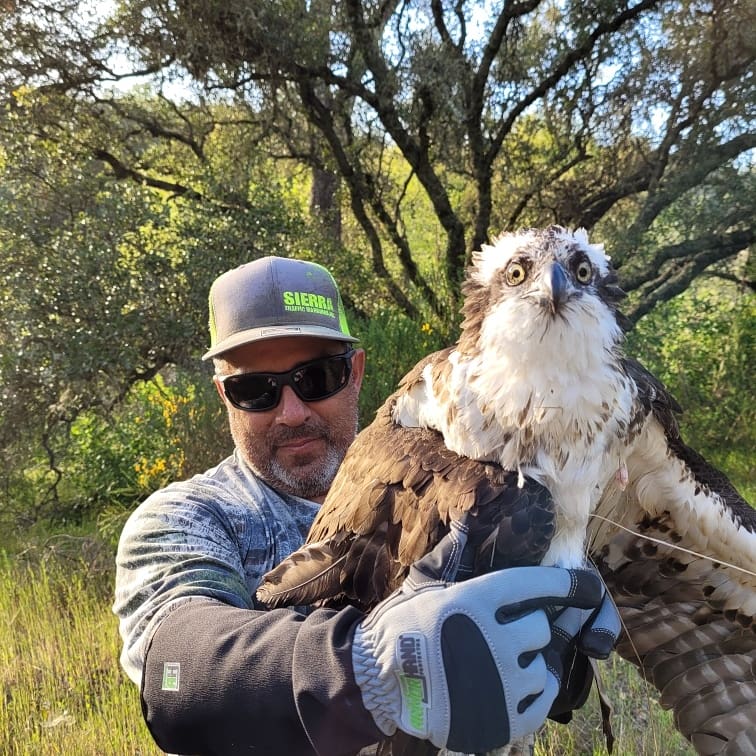
Pete has a poison oak rash in his armpit. The backs of my knees and left shoulder blade are starting to itch. It’s a sign of spring—a sign that last weekend, for the first time in a while, we did something really good.
No, not that. Last weekend we hopped fences, clambered over downed trees, scaled boulders, and hacked through thickets of poison oak in search of an incredible, majestic, injured bird.
LOOK AT THIS BIRD! Have you ever seen anything so dignified? Or so affronted? Here’s how we found ourselves unexpectedly searching a river canyon for an injured osprey: Last weekend, Pete, two friends, and I decided to float down a stretch of whitewater on the South Fork American River. A few miles downstream, we approached a house-sized boulder known to locals as Gorilla Rock because it looks exactly like a gorilla in profile. As we floated, Pete spotted something odd on the river bank: a two-foot-tall, brownish-black and white osprey sitting on a flat rock next to the water.
Continue reading
I.
We’ve been slowly cutting back on meat. It’s better for us and better for the planet. Not to mention the exploited workers on the factory farms—did you see that John Oliver segment? After it came out, we said let’s take things one step further: No more buying meat for our household from the grocery store.
Of course, we’re not going to throw out all those Omaha Steaks in the freezer that our generous family sent for Christmas. And when ordering in, we’ll still allow it. Also, say we go over to a friend’s house for dinner—you know, eventually—and they’ve made a pot roast. Which is… have any of our friends ever made a pot roast? Well, you get the idea.
Point is: no need to stop cold turkey. Hah.
Speaking of which, what are we going to do about the toddler who requests a steady diet of hot dogs, pepperoni, and sliced turkey?
Well yeah, he’s only three. We are the adults.
Let’s try to trick him? Yes, we’ll trick him.
Have you seen all the brands of fake meat out there now—fake chicken nuggets could be an aisle of their own, as if nuggets were ever a real thing.
Look: This “smart sausage” is exactly like a brat. We need to get him into ketchup to really sell it though, I think.
As long as it’s covered in BBQ sauce, and not the main focus of the dish, you’d hardly know this Beyond meat wasn’t real beef.
It’s truly a golden age for meatless meats. The perfect time to be a part-time vegetarian.
There’s no excuse not to, really.
Good for us.
Continue reading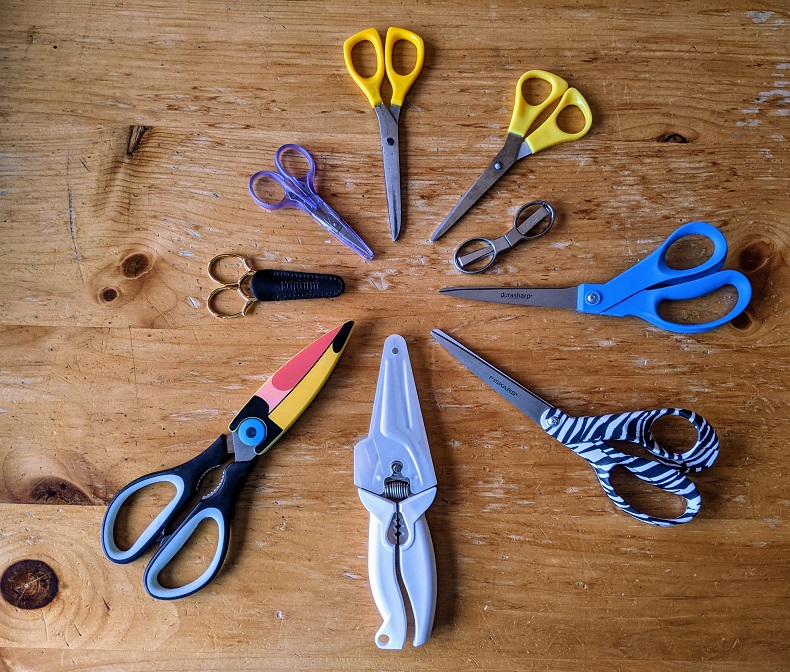
The other day I started counting scissors.
Why?
Because there’s a pandemic.
That should be reason enough. But if you need more, it’s because, spending all this time at home, I got started thinking about how many tools I have that do more or less the same thing. The stand mixer, the hand mixer, the blender, and the food processor. The DVD player, the CD player, and the optical drives in the laptops.
The other day, the tool I was thinking about was scissors. I could think of seven pairs right away, then nine. Most have different functions. When I dug through drawers and boxes, I got up to 14. There are probably more. That Swiss army I used to have, with a tiny folding pair of scissors – it’s lost, but it could be lost in here somewhere.
Because there’s a pandemic, and I’ve had a lot of time to think about the stuff riding out the pandemic with me, I present: All of the scissors in my apartment. In the order in which they appear in the photo above, starting at the top of the circle.
1. This reliable, yellow-handled pair lives in a can on my desk and I grab them any time I just need to cut some paper or get into a padded envelope. I think I bought them in Italy in 1998. If I’m right, and I have managed to hang onto one pair of scissors for 23 years, I am very impressed with myself.
2. The second pair with yellow handles came in a set of three from IKEA. (The other two don’t live here.) They are in a can in the kitchen, where I can grab them whenever I need to get into a food package. They go through the dishwasher often and seem to be surviving.
3. My folding scissors live in an Altoids tin with a bunch of stitch markers, big-eyed needles, and other knitting-related tools. These scissors’ only job is to cut yarn. Once some security folks in the Frankfurt airport spent several minutes digging through my bag for that weird-shaped metal thing they’d seen on the x-ray. (When they found it, they concluded that these scissors were, in fact, legal to carry on a plane, which I knew, which is why I had them.)
4. At some point in 2014 or so, I realized that I needed fabric scissors. (You don’t cut fabric with regular scissors.) So I bought this blue pair.
5. In the summer of 2015, I was on a short trip to New York and made a wee pilgrimage to Mood, the fabric store that featured in Project Runway. I didn’t really need any fabric, but I was excited to be there and wanted a souvenir. I remembered that I needed fabric scissors. I forgot that I had already dealt with that need. I bought the zebra scissors. Now I have two pairs of fabric scissors. I regret nothing.
6. I bought these very strong poultry shears to spatchcock a turkey. I used them once, to spatchcock one turkey. It was fine, but I usually do a chicken for Thanksgiving now.
7. My dad got me toucan kitchen scissors for Christmas one year as a replacement for the IKEA scissors. I always end up using the IKEA scissors, even though these are way cuter. I feel a little bad about that. I do enjoy looking at these.
8. I got these gold-handled embroidery scissors last year because I dropped the old pair too many times, and one of the tips bent. I try not to drop these as often. For embroidery, it’s handy to have very, very pointy scissors, so you can get under any errant stitches and cut through them.
9. The purple-handled embroidery scissors have one wonky point. Sorry, scissors.
10-14, not pictured: I didn’t retake the photo for the last five pairs, because one is a random, not-very-good pair that I bought in Sweden and never use, and the other four are scissors from the office that came home with me last year in a box of craft supplies for the work crafting group. Two are still in their packages.
This seems like a ludicrous number of scissors. When you have the right tool, something that seemed very annoying, finnicky, or just plain impossible – getting a clean cut in fabric or yarn, or laying a turkey out flat for roasting – becomes straightforward. I have used every one of pairs 1-9 in the last year–most of them in the last week.
What scissors do you have that aren’t on this list? Gardening shears, maybe? Some kind of nail scissors? Do you cut hair, or upholstery? Tell me about it in the comments.
Photo: Helen Fields

Last spring, I wasn’t sure how to use Instagram. I mean, I technically knew how to use it. When I logged on, it was honestly keeping me going each day, watching everyone try to figure out what to do at home and seeing that they were just as uncertain as I was. People made sourdough bread, they knitted, they drew rainbows and put them on their windows, they banged pots and pans. But when it came to responding in kind, I wasn’t sure what to do.
Then one of my plants started to grow.
The best way to describe the way I garden is salutary neglect. This phrase, it seems, came from the British loosening their enforcement of trade relations with the colonies in the early 1700s. I have no enforcement whatsoever. I love to buy seed packets and new, hopeful plant starts, and plant them in the garden. I tend them in the first few days, but then something always comes up. (Perhaps not unlike the British—according to the Encyclopedia Britannica, some historians think it would have been impossible for the British to enforce trade across spread-out colonies, others say “a greater cause of salutary neglect was not deliberate but was instead the incompetence, weakness, and self-interest of poorly qualified colonial officials.” Gardening incompetence, weakness and self-interest, that’s me!)
So seeing a thriving plant is always a pleasant surprise. This one started as a low-growing spiky thing, and had stayed that way for a year. In March 2020, it started shooting up toward the sun.
The plant was an echium, a biennial plant which shoots out a flower spike during its second year. These species—there are six of them—are native to the Canary Islands and parts of the west coast of Africa and the Iberian Peninsula. This one, called Echium wildpretti is known for its size—its flower tower can grow up to seven feet.
So I started taking photos of it. And there was much more drama than I thought. In a rainstorm, the spike fell over. A few days later, the tip started to lift skyward again. (Personal drama: I wrote and deleted several penis-themed captions while giggling to myself.) Huge buds grew in a spiral around the spike. Pink flowers appeared, and then an underlayer of purple. The echium toppled over again, and again, it reoriented toward the sun.
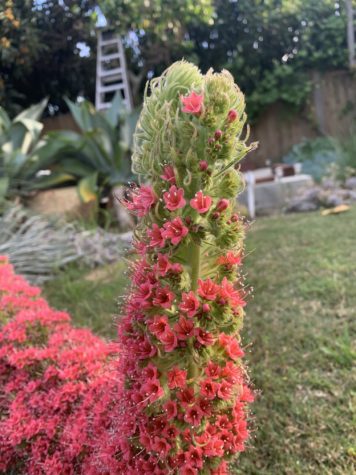
This is the kind of drama I would not have noticed otherwise. But in taking photos of E. wildpretti each day, I could see the small changes. I started looking forward to what would happen next, even when there wasn’t much else to look forward to.
Finally, the tower faded. By then we’d fallen into something of a rhythm at home, or at least something that felt less desperate. Elsewhere in the garden, a few small apricots appeared, and then a surfeit of figs. Sunflowers and pumpkins, then the dump of seed pods from the elm that signals the start of fall.
And now it’s spring again. Because of my incompetence and weakness, I could not remember what year I planted the next set of echium starts. Would I have to wait another year to see a bloom? Then about a week ago, an unassuming plant in the shade started growing upward instead of out. Now it is up above my knees, reaching toward the light.